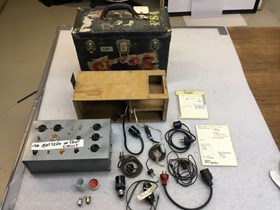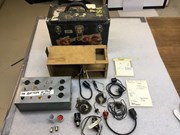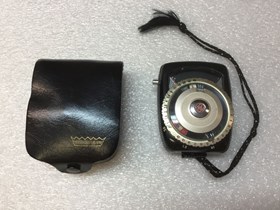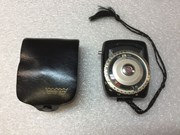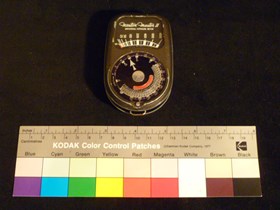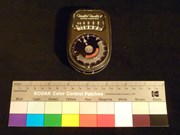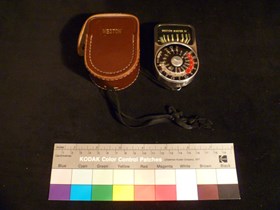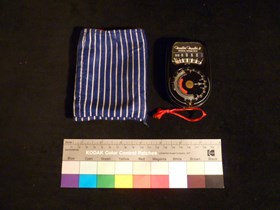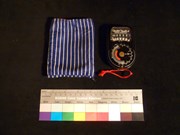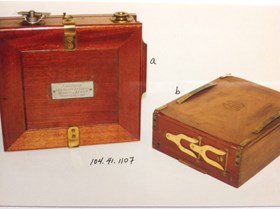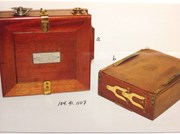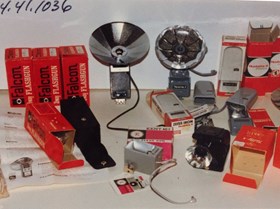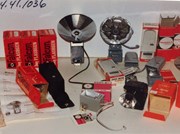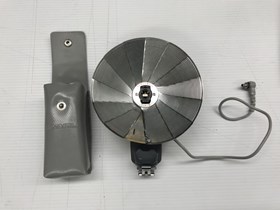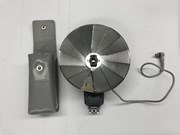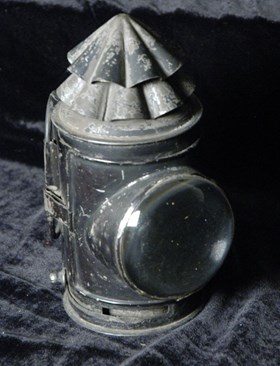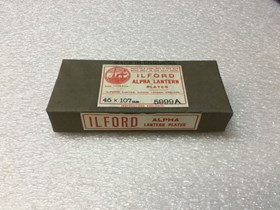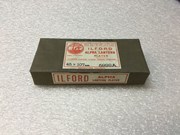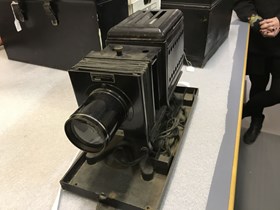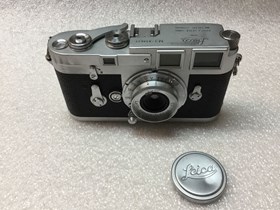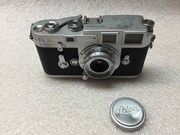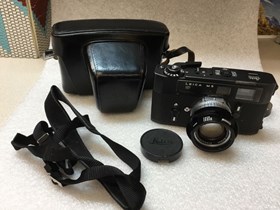Narrow Results By
Equipment Case
https://archives.whyte.org/en/permalink/artifact104.41.0103
- Date
- 1950 – 1980
- Material
- leather; wood; metal; fabric
- Catalogue Number
- 104.41.0103
- Description
- Brown hard-sided travel case with metal corner brackets, reinforcing along all edges, wooden runners along the bottom, front, and back of the case, a leather handle on the lid attached with leather brackets and metal loops, and three metal clasps - the centre one has a keyhole. Attached to the righ…
1 image
- Title
- Equipment Case
- Date
- 1950 – 1980
- Material
- leather; wood; metal; fabric
- Dimensions
- 29.8 x 14.9 x 78.3 cm
- Description
- Brown hard-sided travel case with metal corner brackets, reinforcing along all edges, wooden runners along the bottom, front, and back of the case, a leather handle on the lid attached with leather brackets and metal loops, and three metal clasps - the centre one has a keyhole. Attached to the right-hand metal loop of the handle is a leather travel tag with nothing in it. Throughout the exterior of the case are three faded and worn red and white “FRAGILE CANADIAN PACIFIC EXPRESS” stickers - one on the lid and one on both the front and back - and a Canadian Pacific Railway “DEPARTMENT OF PUBLIC RELATIONS” label with a very faded stamp with Morant’s details. Also on the lid is a gold and red sticker is in the left corner with the case’s manufacturer name - no information about “G.R. TAYLOR & CO.” could be found online.The interior of the case is lined with purple fabric and only contains a small white fabric bag with what feels like rice inside, sealed shut.
- Credit
- Gift of Nicholas Morant, Banff, 2006
- Catalogue Number
- 104.41.0103
Images
This material is presented as originally created; it may contain outdated cultural descriptions and
potentially offensive content.
Read more.
- Date
- 1950 – 1970
- Material
- metal; wood; plastic; leather; paper;
- Catalogue Number
- 104.41.0153 a-e
- Description
- Black hard-sided travel case with metal brackets on the corners, a hinged lid with three metal clasps, and a leather handle attached to the top of the lid with metal loops. The exterior of the case has the remnants of stickers and labels throughout, including a large red and white sticker on the fr…
1 image
- Title
- Equipment Case
- Date
- 1950 – 1970
- Material
- metal; wood; plastic; leather; paper;
- Dimensions
- 30.7 x 20.3 x 40.7 cm
- Description
- Black hard-sided travel case with metal brackets on the corners, a hinged lid with three metal clasps, and a leather handle attached to the top of the lid with metal loops. The exterior of the case has the remnants of stickers and labels throughout, including a large red and white sticker on the front that reads “GLASS.” Attached to the handle by a piece of string is the torn remnants of a CP Rail paper tag. The interior of the box is lined with dark blue velvet and contains a wood particle board box that, when lifted out, exposes three built-in compartments - the small upper one on the right has an opening cut into the top so that the contents could be accessed without removing it from the case. The two smaller compartments of the box contain a miscellaneous collection of power cords and a white metal film canister containing two small light bulbs. Two cords are fed through small holes drilled between the compartments.Sitting on top of the particle board box is a sealed metal light switchboard with various switches, plug outlets, and coloured lights across the top - two more outlets are located on one short side. Resting on top is a strip of paper that reads “NO BATTERY IN TRIP CIRCUIT” in black ink. This switchboard would allow Morant to synchronize and set off studio lights and/or camera flashes from one central location. Also included in the box are two pieces of paper - one is an equipment checklist written on the back of a note card, and the other is a hand-written circuit manual in a plastic envelope.
- Credit
- Gift of Nicholas Morant, Banff, 2006
- Catalogue Number
- 104.41.0153 a-e
Images
This material is presented as originally created; it may contain outdated cultural descriptions and
potentially offensive content.
Read more.
Exposure Meter
https://archives.whyte.org/en/permalink/artifact104.41.0141
- Date
- 1955 – 1958
- Material
- metal; plastic; leather; fabric
- Catalogue Number
- 104.41.0141
- Description
- A General Electric Exposure Meter (type PR-3) in a black leather pouch. The meter has several dials on the front in order to set the exposure, a silver metal button on the left-hand side, a brief instruction plate attached to the back, and a black and gold fabric cord attached to the bottom. It is …
1 image
- Title
- Exposure Meter
- Date
- 1955 – 1958
- Material
- metal; plastic; leather; fabric
- Dimensions
- 3.4 x 6.7 x 8.2 cm
- Description
- A General Electric Exposure Meter (type PR-3) in a black leather pouch. The meter has several dials on the front in order to set the exposure, a silver metal button on the left-hand side, a brief instruction plate attached to the back, and a black and gold fabric cord attached to the bottom. It is mostly made of black plastic - the dials on the front and instruction plate on the back are both metal. The leather pouch has a front flap that snaps closed at the bottom and is mostly open on the inside so as to access the meter’s dials - there are openings on the left-hand side and the bottom for the button and cord. In the bottom right corner of the front flap is an embossed gold crown.
- Credit
- Gift of Nicholas Morant, Banff, 2006
- Catalogue Number
- 104.41.0141
Images
This material is presented as originally created; it may contain outdated cultural descriptions and
potentially offensive content.
Read more.
Exposure Meter
https://archives.whyte.org/en/permalink/artifact104.41.1118
- Date
- 1888
- Material
- metal; paint; plastic
- Catalogue Number
- 104.41.1118
- Description
- Hand held exposure/light meter made by Weston Electrical Instrument Company in a grey metal finish. Along both sides of the meter are a series of protruding lines that allow one to safely grip the object. At the bottom of the artifact there is a metal hook, which would have allowed a string to be a…
1 image
- Title
- Exposure Meter
- Date
- 1888
- Material
- metal; paint; plastic
- Dimensions
- 2.0 x 6.0 x 9.5 cm
- Description
- Hand held exposure/light meter made by Weston Electrical Instrument Company in a grey metal finish. Along both sides of the meter are a series of protruding lines that allow one to safely grip the object. At the bottom of the artifact there is a metal hook, which would have allowed a string to be attached like on the other Weston meter’s owned by Nicholas. There is also no longer a case to protect this particular object. In the top of the exposure meter there is a clear plastic covering. Along the very top there us the name of the manufacturer in white cursive lettering that reads “Weston Master II” and written underneath in capital letters “UNIVERSAL EXPOSURE METER.” Below this is the light scale where the value of the scene would be indicated. The scale contains the values “0” “25” “50” “100” “200” “400” “800” “1600,” which means that the two values on this instrument are calibrated 0-50 and 0-1600. (candles per square foot.)Below there is a circular face with several figures and a dial that turns/rotates. The outside row of figures on the exposure control dial represents the light value settings and corresponds to the light values on the light scale. Below the round dial there is a tiny circular button that is used to set the exposure control dial for film speed. As the dial turns it reveals the “EMULSION SPEED” with a red baize finish that has become worn throughout its life. The row of figures at the bottom of the top dial is the f/stop values and has an “f” to make this more apparent for the user. The row of figures directly below the f/stop settings are the shutter speeds. After setting the exposure control dial to the light value obtained on the light scale, any of the combinations of f/stop and shutter speed directly opposite each other are correct. On the rear of the meter there is a black plastic covering that contains several circular cut outs that are called a hir.ged baffle. This can be swung open (against the case) using the gold latch, which clips into a tiny hole or socket when the user wishes it to be closed. When opened the light sensitive photo cell is directly beneath this baffle and contains several protruding circles. When the baffle is open, the scale range is 0-50; when the baffle is closed, the scale range is 0-1600. Below there is an oval shaped face with extensive information that is held in place with two small screws on both the viewer left and right side. There is silver lettering on a black background that reads “WESTON ELEC. INST. CORP.” “NEWARK, N.J., U.S.A.” A silver backing separates the patent information and has black writing that reads “MODEL 735” on the viewer left side. On the viewer right side the number “7454510” is engraved. In the middle there is a gold-coloured screw with the words “ZERO CORRECTOR” written in black. Below this there is the patent information; “U.S. PATENTS” “2,274,441” “2,073,790” “2,346,555” “2,137,466” “2,463,770.” Below these numbers are the “FOREIGN PATENTS” “FRENCH 862,770” “BRITISH 531,996” “CAN. 347,085” “CAN. 411,975” At the very bottom underneath there is the manufacturer’s location; “MADE IN U.S.A.”
- Subject
- photography
- Nick Morant
- Credit
- Gift of Nicholas Morant, Banff, 2006
- Catalogue Number
- 104.41.1118
Images
This material is presented as originally created; it may contain outdated cultural descriptions and
potentially offensive content.
Read more.
- Date
- 1888
- Material
- leather; metal; nylon; plastic; thread; paint
- Catalogue Number
- 104.41.1119 a-b
- Description
- Hand held light meter in a pear shape with a stainless steel body and leather case. Along both sides of the meter are a series of protruding lines that allow one to safely grip the object. On the viewer right there is a pointer lock, which is locked when positioned upwards and released when positio…
1 image
- Title
- Exposure Meter
- Date
- 1888
- Material
- leather; metal; nylon; plastic; thread; paint
- Dimensions
- 2.0 x 5.0 x 9.0 cm
- Description
- Hand held light meter in a pear shape with a stainless steel body and leather case. Along both sides of the meter are a series of protruding lines that allow one to safely grip the object. On the viewer right there is a pointer lock, which is locked when positioned upwards and released when positioned downward. At the bottom of the artifact there is a metal hook, which has a black string running through. In the top of the light meter there is clear plastic covering. Written in capital letters is “WESTON MATER IV” above the light scale. The lights scale contains the numbers “0” “25” “50” “100” “200” “400” “800” “1600,” which means that the 2 values calibrated on this instrument are 0-50 and 0-1600.Below there is another light scale in the form of a circular face with several figures and a dial that turns/rotates. The dial on the outside has a series of protruding lines to make movement easier and contains a row of figures. This dial controls the lens aperture (f/stop) scale and has a series of values representing the focal length of the lens; “1” “1.4” “2” “2.8” “4” “5.6”. On the same dial there is also the letters “EVS,” which stands for the exposure value setting with a cut out window that reveals the EVS values. Working in a clockwise direction (on the same dial) there is also the letters “U,” “A with “1/2” over top,” an enclosed arrow that is known as the normal arrow, a “C” with “2x” on top of it, and a “0”. As this dial is turned it reveals a partly red baize and black numbers on a silver background that represents the shutter speeds in fractions of seconds. The inside dial has a series of light scale values and an exposure index window that line up with the “U,” “A,” normal arrow, “C,” and “0.” On the opposite side of the exposure index window is the exposure index knob. On the rear of the meter there is a black plastic covering that contains several circular cut outs that are called a hir.ged baffle. This can be swung open (against the case) using the gold latch, which clips into a tiny hole or socket when the user wishes it to be closed. When opened the light sensitive photo cell is directly beneath this baffle and contains several protruding circles. When the baffle is open, the scale range is 0-50; when the baffle is closed, the scale range is 0-1600. Below there is an oval shaped face with extensive information that is held in place with two small screws on both the viewer left and right side. There is black lettering on a silver background that reads “UNIVERSAL EXPOSURE METER” “MODEL 745” SER.W” and “107522” engraved. Below the manufacturer information is listed; “DAYSTROM. INCORPORATED” “WESTON INSTRUMENTS DIVISION”. “NEWARK. N.J.. U.S.A.” In the middle there is a gold-coloured screw with the words “ZERO CORRECTOR” written in black. On the viewer left side of the zero corrector there is patent information; “U.S. PATENTS” “2463770” and on the viewer right side “FOREIGN PATS” “CAN. 411975”. At the very bottom on either side of a circular cut out are “ASA” and “K=1.0” written. Underneath “MADE IN JAPAN” has also been written.There is also a brown leather case with this object. The front has “WESTON” written in gold letters. On the viewer left there is a brown button that allows the case to be opened or fastened shut. The leather has been stitched together with light brown thread that is visible. The bottom of the case has an opening for the black string to be strung through so that the light meter and case are attached. On the rear there is a brown leather strap stitched.
- Subject
- photography
- Nick Morant
- Credit
- Gift of Nicholas Morant, Banff, 2006
- Catalogue Number
- 104.41.1119 a-b
Images
This material is presented as originally created; it may contain outdated cultural descriptions and
potentially offensive content.
Read more.
- Date
- 1888
- Catalogue Number
- 104.41.1120 a-b
- Description
- Hand held light meter in a pear shape with a stainless steel body and leather case. Along both sides of the meter are a series of protruding lines that allow one to safely grip the object. At the bottom of the artifact there is a metal hook, which has a red string running through.There is a clear p…
1 image
- Title
- Exposure Meter
- Date
- 1888
- Description
- Hand held light meter in a pear shape with a stainless steel body and leather case. Along both sides of the meter are a series of protruding lines that allow one to safely grip the object. At the bottom of the artifact there is a metal hook, which has a red string running through.There is a clear plastic covering located at the top of the meter. Written in cursive letters is the company name “WESTON MATER II”. Underneath this written in capital letters is “UNIVERSAL EXPSOURE METER”. The light scale underneath contains the numbers “0” “25” “50” “100” “200” “400” “800” “1600,” which means that the 2 values calibrated on this instrument are 0-50 and 0-1600. Underneath the scale the word “Light” is present. Below there is another light scale in the form of a circular face with several figures and a dial that turns/rotates. The outside row of figures on the exposure control dial represents the light value settings and corresponds to the light values on the light scale at the top. The row of figures at the bottom of the top dial is the f/stop values and has an “f” to make this more apparent for the user.. On the same dial there is silver letters that have a line that correspond to the figures on the outside dial; “U,” “A with “1/2” underneath,” an arrow that is known as the normal arrow, a “C” with “2x” below it, and a “0”. As this dial is turned it reveals a partly red baize and the emulsion speed, which is self-evident as the words “EMULSION SPEED” are present. The row of figures directly below the f/stop settings are the shutter speeds. The outside row of figures is the light values, which is apparent as the word “LIGHT” with an arrow points to these values. After setting the exposure control dial to the light value obtained on the light scale, any of the combinations of f/stop and shutter speed directly opposite each other are correct. Below the round dial there is a tiny circular button that is used to set the exposure control dial for film speed.On the rear of the meter there is a black plastic covering that contains several circular cut outs that are called a hir.ged baffle. This can be swung open (against the case) using the gold latch, which clips into a tiny hole or socket when the user wishes it to be closed. When opened the light sensitive photo cell is directly beneath this baffle and contains several protruding circles. When the baffle is open, the scale range is 0-50; when the baffle is closed, the scale range is 0-1600. Below there is an oval shaped face with extensive information that is held in place with two small screws on both the viewer left and right side. There is silver lettering on a black background that reads “WESTON ELEC. INST. CORP.” “NEWARK, N.J., U.S.A.” A silver backing separates the patent information and has black writing that reads “MODEL 735” on the viewer left side; “No” is present in the middle; “8284703” is engraved on the viewer right side. In the middle there is a brass screw with the words “ZERO CORRECTOR” written in black around its circumference. On the viewer left side of the zero corrector is the patent information; “U.S. PATENTS” “1,779,574” “1,982,406” “2,073,790” and on the viewer right side continued patent information “U.S. PATENTS” “2,137,466” “2,274,441” “2,346,555”. Below these numbers are the “FOREIGN PATENTS” “FRENCH 862,770” “BRITISH 531,996” “CAN. 347,085” “CAN. 411,975” At the very bottom underneath there is the manufacturer’s location; “MADE IN U.S.A.” written in black on a silver background.There is also a blue case with white stripes and a red inner lining that would be used to protect the case. This would not have been originally sold with the exposure meter and was most likely hand made in an effort to protect the meter. Blue stitches hold the fabric together and are visible.
- Subject
- photography
- Nick Morant
- Credit
- Gift of Nicholas Morant, Banff, 2006
- Catalogue Number
- 104.41.1120 a-b
Images
This material is presented as originally created; it may contain outdated cultural descriptions and
potentially offensive content.
Read more.
- Date
- prior to 1970
- Material
- metal; paper
- Catalogue Number
- 110.01.1050
- Description
- Metal film canisters, 54 in number, in colours of yellow, red, green, white and blue. In a paper box with paper dividers. Box is "Buchan-Sinclair Limited"
- Title
- Film Canister
- Date
- prior to 1970
- Material
- metal; paper
- Description
- Metal film canisters, 54 in number, in colours of yellow, red, green, white and blue. In a paper box with paper dividers. Box is "Buchan-Sinclair Limited"
- Subject
- hobbies
- photography
- Credit
- Gift of Catharine Robb Whyte, O. C., Banff, 1979
- Catalogue Number
- 110.01.1050
This material is presented as originally created; it may contain outdated cultural descriptions and
potentially offensive content.
Read more.
- Date
- 1885 – 1900
- Material
- wood; metal
- Catalogue Number
- 104.41.1107 a,b
- Description
- (a) Wooden film roller with brass fittings. Metal plate on top reads: “EASTMAN DRY PLATE & FILM CO. Rochester, N.Y., U.S.A. PATENTED MAY 5, 1885.” (b) Wooden film roller with brass fittings, top stamped: “EASTMAN KODAK CO. PAT. MAY 5, 1885. OTHER PATENTS APPL’D FOR IN ALL COUNTRIES.”
1 image
- Title
- Film Roller
- Date
- 1885 – 1900
- Material
- wood; metal
- Dimensions
- 6.0 x 18.0 cm
- Description
- (a) Wooden film roller with brass fittings. Metal plate on top reads: “EASTMAN DRY PLATE & FILM CO. Rochester, N.Y., U.S.A. PATENTED MAY 5, 1885.” (b) Wooden film roller with brass fittings, top stamped: “EASTMAN KODAK CO. PAT. MAY 5, 1885. OTHER PATENTS APPL’D FOR IN ALL COUNTRIES.”
- Subject
- photography
- Vaux family
- Credit
- Gift of Molly Vaux, New York, USA, 1999
- Catalogue Number
- 104.41.1107 a,b
Images
This material is presented as originally created; it may contain outdated cultural descriptions and
potentially offensive content.
Read more.
Flash Accessories
https://archives.whyte.org/en/permalink/artifact104.41.1036%20a-f
- Date
- 1956 – 1968
- Material
- plastic, metal, paper
- Catalogue Number
- 104.41.1036 a-f
- Description
- Clip-on flash bulb reflectors and sync cords in boxes; all attachments are in their original boxes and never been used; (a) Falcon flashgun made in Japan; (11.2x4.7x4.7) 4 pieces; has black vinyl case; thin metal leaves which fan out; cord and instructions; (b) Zeiss Ikon Ikoblitz 5 &6 made in Germ…
1 image
- Title
- Flash Accessories
- Date
- 1956 – 1968
- Material
- plastic, metal, paper
- Description
- Clip-on flash bulb reflectors and sync cords in boxes; all attachments are in their original boxes and never been used; (a) Falcon flashgun made in Japan; (11.2x4.7x4.7) 4 pieces; has black vinyl case; thin metal leaves which fan out; cord and instructions; (b) Zeiss Ikon Ikoblitz 5 &6 made in Germany (12.0x4.7x3.2); 4 pieces; cord and instructions; thin metal leaves fan out; when folded plastic sleeve fits over unit; (c) King Deluxe made in Japan (11.0x4.7x4.2); cast metal body; cord; thin metal leaves fan out to make reflector; clear vinyl case, instructions, 3 pieces; (d) Agfa Tully K made in Germany (8.0x4.8x6.0); hard plastic case with leather strap and hinge; 2 buttons, when pushed to slide, pushes reflector from inside out; 2 pieces; (e) Kentag-1, made in Japan (7.8x5.4x4.1); bulb slides into clip; has cord,instructions; (f) Pixur bounce flash gun, Japan; (11.8x4.6x5.5); clear vinyl case; instructions and cord; metal leaves fan out for reflector.
- Subject
- photography
- Banff Camera
- Credit
- Gift of Banff Camera Shop Ltd., Banff, 1986
- Catalogue Number
- 104.41.1036 a-f
Images
This material is presented as originally created; it may contain outdated cultural descriptions and
potentially offensive content.
Read more.
Flash Battery Unit
https://archives.whyte.org/en/permalink/artifact104.41.1299
- Date
- 1950 – 1975
- Material
- rubber; plastic; metal; dry-cell battery; ball point pen ink
- Catalogue Number
- 104.41.1299
- Description
- black and blue faux leather textured trapezoid power pack case with riveted black rubber strap; metal plaque on large side with Strobo Research logo [lightning shaped red “S” over black “R”] and inscription: “STROBOFLASH IV / MADE IN U.S.A. BY / GRAFLEX INC., ROCHESTER, N.Y.”; below has been taped …
1 image
- Title
- Flash Battery Unit
- Date
- 1950 – 1975
- Material
- rubber; plastic; metal; dry-cell battery; ball point pen ink
- Dimensions
- 22.5 x 16.0 cm
- Description
- black and blue faux leather textured trapezoid power pack case with riveted black rubber strap; metal plaque on large side with Strobo Research logo [lightning shaped red “S” over black “R”] and inscription: “STROBOFLASH IV / MADE IN U.S.A. BY / GRAFLEX INC., ROCHESTER, N.Y.”; below has been taped a thin strip of yellowed paper with handwritten date in blue ballpoint pen ink: “MAY 1976”; black coil cord attached to one side, ending with a female four prong round plug with a red dot; power setting dial on the top
- Subject
- Nicholas Morant
- photography
- Credit
- Gift of Nicholas Morant, Banff, 2006
- Catalogue Number
- 104.41.1299
Images
This material is presented as originally created; it may contain outdated cultural descriptions and
potentially offensive content.
Read more.
- Date
- 1955 – 1960
- Material
- metal; plastic; leather;
- Catalogue Number
- 104.41.1205 a-b
- Description
- A: Flash: Rectangle device that has a dial on the back with two lights (green and red). The dial has a red interior and numbers all around it. there is a small piece of tape holing the dial in place. the words: Open; Flash; Test Button; Set this point at guide Number; Lamp to subject, Distance in F…
1 image
- Title
- Flash Camera
- Date
- 1955 – 1960
- Material
- metal; plastic; leather;
- Dimensions
- 11.5 x 5 x 4 cm
- Description
- A: Flash: Rectangle device that has a dial on the back with two lights (green and red). The dial has a red interior and numbers all around it. there is a small piece of tape holing the dial in place. the words: Open; Flash; Test Button; Set this point at guide Number; Lamp to subject, Distance in Feet; Made in Japan.; Honeywell; Tilt-A-Mite can be read. The top of the flash has an adjustable ball to allow the operator to maneuver the flash direction. The bottom hardware attaches to a rangefinder camera. Front of flash has a silver retractable disk that folds for storage. a bulb would then be placed in the centre. B: Case: simple gray case with a snap button to close. the front and bottom read: Honeywell; JAPAN.
- Credit
- Gift of Harold C. Whyte, Penticton, 2017
- Catalogue Number
- 104.41.1205 a-b
Images
This material is presented as originally created; it may contain outdated cultural descriptions and
potentially offensive content.
Read more.
- Date
- prior to 1977
- Material
- wood; metal
- Catalogue Number
- 104.41.0274
- Description
- A simple wooden folding stand for prints. The stand is made of two sections fasten together with screws with enough room to fold open, the frames are made in square horseshoe shapes, with the smaller one in the inside. On opposite sides at the top of the sections is ribbing, when folded open. The l…
1 image
- Title
- Folding Stand
- Date
- prior to 1977
- Material
- wood; metal
- Dimensions
- 17.7 x 17.8 cm
- Description
- A simple wooden folding stand for prints. The stand is made of two sections fasten together with screws with enough room to fold open, the frames are made in square horseshoe shapes, with the smaller one in the inside. On opposite sides at the top of the sections is ribbing, when folded open. The legs of the stand are angled at the bottom.
- Credit
- Gift of Pearl Evelyn Moore, Banff, 1977
- Catalogue Number
- 104.41.0274
Images
This material is presented as originally created; it may contain outdated cultural descriptions and
potentially offensive content.
Read more.
- Date
- prior to 1977
- Material
- paper; cardboard; glass
- Catalogue Number
- 104.41.0278 a-d
- Description
- A set of two paper frames (a) one narrower window and b) slightly larger window , (c) a matte, and a glass panel (10.1 x 8.2). On the bottom of the two frames text reads “CHARLES R. PANCOAST” “PHILADELPHIA” and a logo in the bottom right corner. The back of the frames are black.
1 image
- Title
- Frames Paper
- Date
- prior to 1977
- Material
- paper; cardboard; glass
- Dimensions
- 9.8 x 8.0 cm
- Description
- A set of two paper frames (a) one narrower window and b) slightly larger window , (c) a matte, and a glass panel (10.1 x 8.2). On the bottom of the two frames text reads “CHARLES R. PANCOAST” “PHILADELPHIA” and a logo in the bottom right corner. The back of the frames are black.
- Subject
- photography
- photography accessory
- frame
- Moore
- Credit
- Gift of Pearl Evelyn Moore, Banff, 1977
- Catalogue Number
- 104.41.0278 a-d
Images
This material is presented as originally created; it may contain outdated cultural descriptions and
potentially offensive content.
Read more.
Handheld Flash
https://archives.whyte.org/en/permalink/artifact104.41.0139
- Date
- 1950 – 1970
- Material
- metal; plastic; cardboard
- Catalogue Number
- 104.41.0139
- Description
- A handheld flash with an expandable reflective disk housed in a black plastic pouch inside the original cardboard box.The flash is mostly black with grey accents and has a metal hook on the bottom where it would attach to a camera, an articulated head so the disk could move, a distance gauge on the…
1 image
- Title
- Handheld Flash
- Date
- 1950 – 1970
- Material
- metal; plastic; cardboard
- Dimensions
- 4.7 x 4.7 x 11.1 cm
- Description
- A handheld flash with an expandable reflective disk housed in a black plastic pouch inside the original cardboard box.The flash is mostly black with grey accents and has a metal hook on the bottom where it would attach to a camera, an articulated head so the disk could move, a distance gauge on the back, two small rectangular buttons on the back [one red and one green], and a black plastic cord coming out of the front just below the disk.
- Credit
- Gift of Nicholas Morant, Banff, 2006
- Catalogue Number
- 104.41.0139
Images
This material is presented as originally created; it may contain outdated cultural descriptions and
potentially offensive content.
Read more.
Handheld Flash
https://archives.whyte.org/en/permalink/artifact104.41.0140
- Date
- 1950 – 1960
- Material
- plastic; metal; cardboard
- Catalogue Number
- 104.41.0140
- Description
- A cream-coloured plastic handheld flash with an expandable reflective disk in a clear plastic pouch and housed in the original black and yellow Pixur cardboard box.The flash has a circular foot on the bottom where it can attach to a camera, a red button on the front, a black button on the right-han…
1 image
- Title
- Handheld Flash
- Date
- 1950 – 1960
- Material
- plastic; metal; cardboard
- Dimensions
- 4.8 x 4.8 x 12.0 cm
- Description
- A cream-coloured plastic handheld flash with an expandable reflective disk in a clear plastic pouch and housed in the original black and yellow Pixur cardboard box.The flash has a circular foot on the bottom where it can attach to a camera, a red button on the front, a black button on the right-hand side, a distance gauge on the back, a panel on the back opens to load batteries, and a dial on the front to reel in the attachment cord. The head can articulate so the reflective disk can move. The cardboard box has a “BANFF CAMERA” price tag on one short end.
- Credit
- Gift of Nicholas Morant, Banff, 2006
- Catalogue Number
- 104.41.0140
Images
This material is presented as originally created; it may contain outdated cultural descriptions and
potentially offensive content.
Read more.
Kerosene Lantern
https://archives.whyte.org/en/permalink/artifact102.05.1018
- Date
- 1880 – 1885
- Material
- metal; glass
- Catalogue Number
- 102.05.1018
- Description
- Black metal lantern with large glass lens in opening door. Inside is a removable fuel reservoir with knob to adjust wick. Sliding screen controls amount of light. “Private Property. VAUX 84” scratched into base of lantern.
1 image
- Title
- Kerosene Lantern
- Date
- 1880 – 1885
- Material
- metal; glass
- Dimensions
- 17.0 x 9.0 cm
- Description
- Black metal lantern with large glass lens in opening door. Inside is a removable fuel reservoir with knob to adjust wick. Sliding screen controls amount of light. “Private Property. VAUX 84” scratched into base of lantern.
- Subject
- photography
- Vaux family
- camping
- hiking
- Credit
- Gift of Molly Vaux, New York, USA, 1999
- Catalogue Number
- 102.05.1018
Images
This material is presented as originally created; it may contain outdated cultural descriptions and
potentially offensive content.
Read more.
Lantern Plates
https://archives.whyte.org/en/permalink/artifact104.41.0206
- Date
- 1889 – 1910
- Material
- paper; glass;
- Catalogue Number
- 104.41.0206
- Description
- One paper-wrapped package of 45x107mm Ilford Alpha Lantern Plates with white and red paper adhesive labels on the top and front of the package containing manufacturer details. These lantern plates would serve as the positive mount for the lantern slide made from the original negative. Lantern slide…
1 image
- Title
- Lantern Plates
- Date
- 1889 – 1910
- Material
- paper; glass;
- Dimensions
- 2.0 x 11.6 x 5.3 cm
- Description
- One paper-wrapped package of 45x107mm Ilford Alpha Lantern Plates with white and red paper adhesive labels on the top and front of the package containing manufacturer details. These lantern plates would serve as the positive mount for the lantern slide made from the original negative. Lantern slides are glass-based transparencies that were displayed by being projected through an early projector called a magic lantern. Starting as hand-painted images on glass, lantern slides quickly adapted to first black-and-white and then colour photography and faded from popularity with the rise of celluloid film and motion pictures.
- Credit
- Gift of Robert Crosby Family, Banff, 1998
- Catalogue Number
- 104.41.0206
Images
This material is presented as originally created; it may contain outdated cultural descriptions and
potentially offensive content.
Read more.
Lantern Slide Projector
https://archives.whyte.org/en/permalink/artifact105.05.1036%20a%2c%20b
- Date
- 1955
- Material
- metal; fabric
- Catalogue Number
- 105.05.1036 a, b
- Description
- Bausch and Lomb Optical Lantern Slide Projector (a) attached to bottom of case. Fabric cord at bottom. Two fabric straps are attached to the bottom exterior. The lid to the projector case has a latch on either side to secure the lid to the base. (b) All components are black.
1 image
- Title
- Lantern Slide Projector
- Date
- 1955
- Material
- metal; fabric
- Description
- Bausch and Lomb Optical Lantern Slide Projector (a) attached to bottom of case. Fabric cord at bottom. Two fabric straps are attached to the bottom exterior. The lid to the projector case has a latch on either side to secure the lid to the base. (b) All components are black.
- Subject
- photography
- Rev. Larry Scott
- Credit
- Gift of Larry Scott, Banff, 1992
- Catalogue Number
- 105.05.1036 a, b
Images
This material is presented as originally created; it may contain outdated cultural descriptions and
potentially offensive content.
Read more.
- Date
- 1954 – 1966
- Material
- metal; plastic; glass;
- Catalogue Number
- 104.41.0210
- Description
- Leica M3 black and silver camera. The camera features the viewfinder on the far left, with ports for a flash and a light beside it [the light port has a yellowed rubber plug in it], as well as a rapid film advance lever on top - a new feature for the M3. Also on the top of the camera is a slot for …
1 image
- Title
- Leica Camera
- Date
- 1954 – 1966
- Material
- metal; plastic; glass;
- Dimensions
- 7.5 x 5.0 x 14.7 cm
- Description
- Leica M3 black and silver camera. The camera features the viewfinder on the far left, with ports for a flash and a light beside it [the light port has a yellowed rubber plug in it], as well as a rapid film advance lever on top - a new feature for the M3. Also on the top of the camera is a slot for accessories such as flashes, viewfinders, and adapters. The camera is fit with a f=2,8 cm 1:6,3 lens with a plain metal lens cap that has the Leica logo stamped on it. Small metal wire triangles are looped through small holes on both sides of the camera, possibly where a carry strap would be attached. There is no film in the camera.
- Subject
- Peter Whyte
- photography
- camera equipment;
- Credit
- Gift of Catharine Robb Whyte, O. C., Banff, 1979
- Catalogue Number
- 104.41.0210
Images
This material is presented as originally created; it may contain outdated cultural descriptions and
potentially offensive content.
Read more.
- Date
- 1971 – 1975
- Material
- metal; plastic; glass; fabric; leather;
- Catalogue Number
- 104.41.0211 a,b
- Description
- Black Chrome 2-Lug Leica M5 with a black fabric carry strap [unattached] in a black leather carry case with strap. The camera has a removable plate on the bottom so that the film can be loaded - while the plate is off, a panel on the back of the camera can be opened to check the position of the fil…
1 image
- Title
- Leica Camera
- Date
- 1971 – 1975
- Material
- metal; plastic; glass; fabric; leather;
- Dimensions
- 8.7 x 9.0 x 15.2 cm
- Description
- Black Chrome 2-Lug Leica M5 with a black fabric carry strap [unattached] in a black leather carry case with strap. The camera has a removable plate on the bottom so that the film can be loaded - while the plate is off, a panel on the back of the camera can be opened to check the position of the film inside. Also on the back is the combined view and range finder in the top left corner and two small outlets for attachments [such as flashes and external lights] with a small black rubber dual plug. The top of the camera features the standard Leica attachment slot and shutter dial, but the M5 has an improved rapid transport lever to wind the shutter and advance the film faster than the M4 did. The camera is fit with a f=5 cm 1:2 lens with a black plastic filter attachment that also holds the black plastic lens cap in place. On the left-hand side are two vertical strap lugs for the fabric carry strap, between which is the housing for the self timer/internal flash battery. The leather carry case consists of two pieces: the base, which attaches to the camera via a screw that fits into the bottom right corner, and the removable lid that snaps onto the back of the base piece - the carry strap is attached with metal brackets to the upper part of the base piece.
- Subject
- photography
- camera equipment
- Credit
- Gift of Catharine Robb Whyte, O. C., Banff, 1979
- Catalogue Number
- 104.41.0211 a,b
Images
This material is presented as originally created; it may contain outdated cultural descriptions and
potentially offensive content.
Read more.



